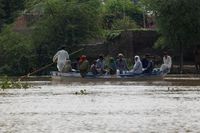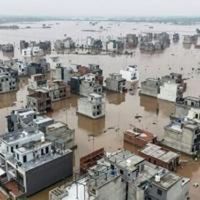As Pakistan’s monsoon season barrels on, the eastern province of Punjab is facing one of the worst flooding disasters in its recent history. By August 31, 2025, authorities confirmed that nearly 750,000 people had been evacuated from high-risk flood zones, with over two million residents affected and at least 33 killed in just the past week. Rescue and relief efforts, described by the Punjab Disaster Management Authority as the largest in the province’s history, are ongoing as officials race against time and nature to save lives and property.
Packed with nearly half of Pakistan’s 255 million people, Punjab is no stranger to monsoon rains. But this year’s deluge, intensified by heavy downpours and excess water released from upstream India, has pushed the region to a breaking point. According to the National Disaster Management Authority (NDMA), since June 26, monsoon-related incidents have killed at least 831 people and injured 1,121 nationwide. Punjab alone has reported 191 deaths in that period, second only to the northwestern province of Khyber Pakhtunkhwa, which has seen 480 fatalities.
The scale of devastation is staggering. Over 2,200 villages in Punjab have been swamped, and more than 8,986 houses across Pakistan have been damaged—2,093 of them completely destroyed and 6,893 partially. Roads and bridges haven’t been spared either, with 661 kilometers of roads and 238 bridges damaged, further complicating rescue operations. Livestock losses are mounting, too: more than 6,100 animals have perished, and roughly 500,000 have been evacuated alongside their owners in Punjab alone.
What makes this year’s flooding particularly alarming is the simultaneous ‘super flood’ state of Punjab’s three main rivers—the Chenab, Ravi, and Sutlej—for the first time in Pakistan’s history. As Provincial Disaster Management Authority (PDMA) Director General Punjab Irfan Ali Kathia explained at a news briefing, "As per the latest deaths reported, the total number of flood-related deaths has risen to 33 [this week]." He also noted, "Nearly 750,000 people had been evacuated from high-risk flood areas to safer locations while at least 2,200 villages in Punjab and over two million people had been affected by the floods, warning that both numbers were continuing to rise," as reported by Dawn.
Punjab Chief Minister Maryam Nawaz emphasized the scale of the response on social media, writing, "The result is 746,664 human evacuations and close to 500,000 animal/livestock evacuations in just a few days." The logistical challenge is immense: rescue teams have deployed over 800 boats and 1,300 emergency workers, and more than 500 relief centers have been set up, many in schools shuttered for the summer holidays. In Lahore, a city of 14 million, torrential rain on August 30 left several neighborhoods underwater, compounding the misery for urban residents.
The crisis has been aggravated by relentless rainfall and the release of water from Indian dams upstream. The PDMA has previously reported that India’s Bhakra Dam is currently 84 percent full, Pong Dam 94 percent, and Thein Dam 92 percent, raising concerns of further cross-boundary surges. Pakistan has long accused India of releasing excess flows into downstream rivers during monsoon peaks, which officials say intensifies flood risks in Punjab’s agricultural heartland. The NDMA’s daily reports have echoed these concerns, noting that the true scale of destruction may be even higher than current figures suggest, as some daily situation reports have yet to be received from the hardest-hit areas.
River flow rates present a daunting picture: as of August 31, around 900,000 cusecs were surging through the Chenab in Jhang district, creating a critical situation. The Sutlej river at Islam Headworks was experiencing flows above 100,000 cusecs, while the Ravi had already discharged 200,000 cusecs. At Balloki, the water level hit 211,000 cusecs, with an additional 20,000 cusecs pouring in from Nankana Sahib. The Punjab PDMA has warned of a very heavy rain forecast in the upper regions of the Sutlej, Beas, Ravi, and Chenab rivers from September 1 to 3, cautioning that it could cause “extremely high to unprecedented flood surges.”
The floodwaters are not expected to recede soon. The NDMA has cautioned that the threat is likely to spread further south, with the Indus River at Guddu and Sukkur barrages expected to reach very high flood levels between September 4 and 5. This rolling disaster follows on the heels of another tragedy earlier in August, when more than 400 people died in Khyber Pakhtunkhwa province due to landslides and mudslides triggered by torrential rains. The country’s vulnerability to extreme weather is nothing new: just three years ago, the 2022 monsoon floods submerged one-third of Pakistan, killed 1,700 people, and wiped out vast swathes of agricultural land.
For those displaced, the struggle is far from over. The NDMA has begun dispatching emergency ration supplies to flood-hit districts, working alongside provincial authorities and the private sector. Relief convoys carrying 46-kilogram food packages, each with 22 essential items, have been sent to Wazirabad and Hafizabad, with aid already reaching Narowal and Sialkot and deliveries to Chiniot and Jhang in preparation. Prime Minister Shehbaz Sharif has directed that assistance be scaled up in coordination with provincial governments, recognizing the immense needs on the ground. Yet, with thousands of homes destroyed and critical infrastructure damaged, the road to recovery will be long and arduous.
The human toll is matched by economic and agricultural losses. Punjab, often called Pakistan’s breadbasket, is seeing vast tracts of farmland underwater, threatening food security for millions. With more heavy rains forecasted and river levels still rising, the risk of further devastation looms large. Officials from the Punjab PDMA and NDMA are urging residents in vulnerable areas to heed evacuation orders and prepare for possible further displacement.
Pakistan’s experience this monsoon season is a stark reminder of the country’s exposure to climate extremes, exacerbated by upstream water management and the unpredictability of weather patterns. As the floodwaters continue their destructive course, the resilience of Pakistan’s people—and the resolve of its officials—will be tested yet again. For now, the focus remains on saving lives, delivering aid, and bracing for whatever comes next.


